Hsin-Po Wang's Website
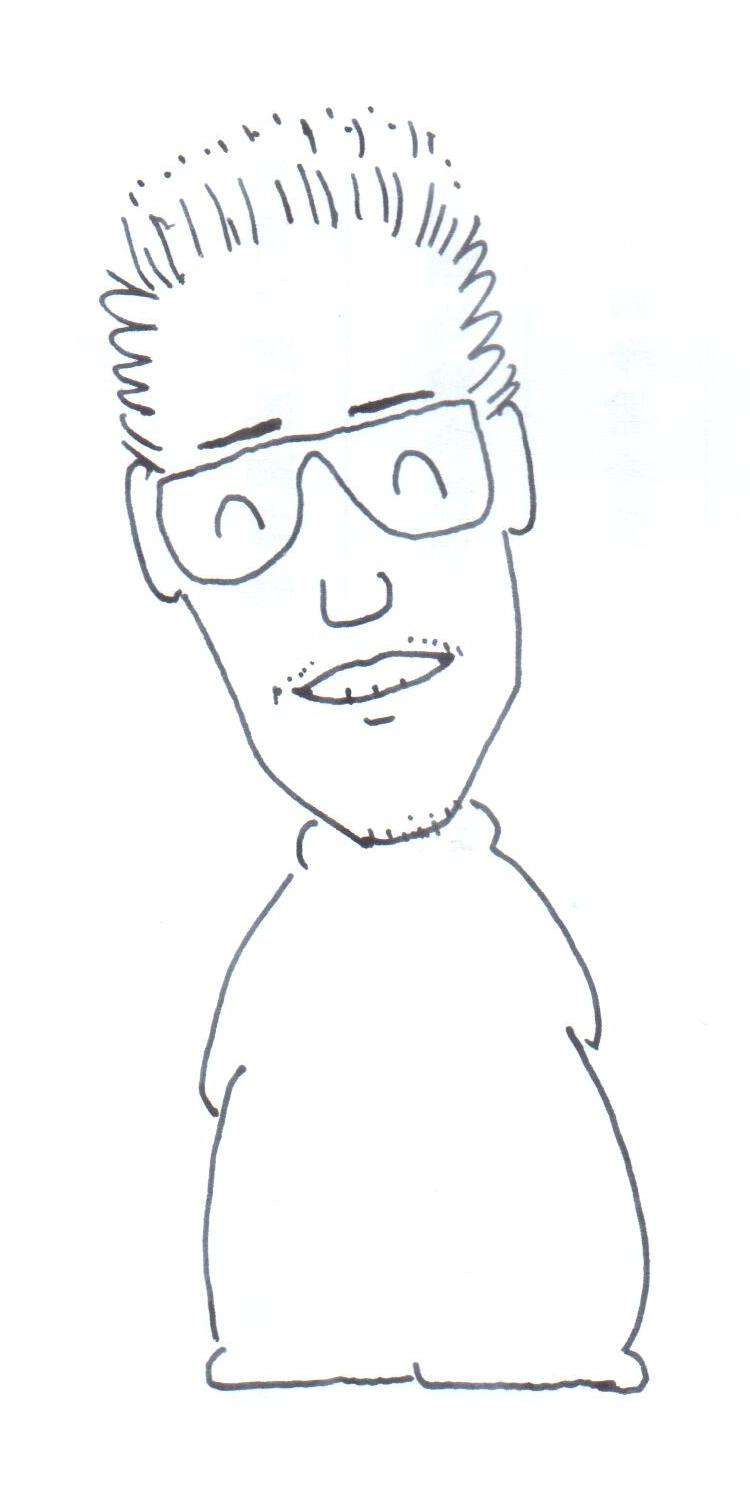
Fellow @ Simons Institute
TikZ TeX TalK
Cycloid
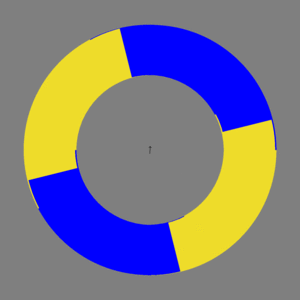
% cycloid.tex
\documentclass[tikz]{standalone}
\begin{document}
\def\wheel#1;{
\begin{scope}#1
\clip\pgfextra{\pgfseteorule}circle(5)circle(3);
\fill[yellow!90!black](-9,-9)rectangle(9,9);
\fill[rotate=\f*14,blue](-9,-9)rectangle(0,0)rectangle(9,9);
\end{scope}
}
\foreach\f in{1,...,90}{ % frame
\tikz{
\fill[gray](-6,-6)rectangle(6,6);
\pgfmathsetmacro\dx{0.05*cos(-\f*4)}
\pgfmathsetmacro\dy{0.05*sin(-\f*4)}
\wheel[shift={(\dx,\dy)},rotate=-14]; % help wheel
\wheel[shift={(-\dx,-\dy)},rotate=14]; % help wheel
\wheel[]; % main wheel
\draw[->,scale=3](\dy,-\dx)--(-\dy,\dx);
}
}
\end{document}
Convert pdf to gif with terminal command (with ImageMagick installed)
convert -delay 2 cycloid.pdf cycloid.gif
or with this command that does anti-aliasing
convert -delay 2 -density 300 -resize 300x300 cycloid.pdf cycloid.gif
This is inspired by じゃがりきん’s twitter post.
Diffuse
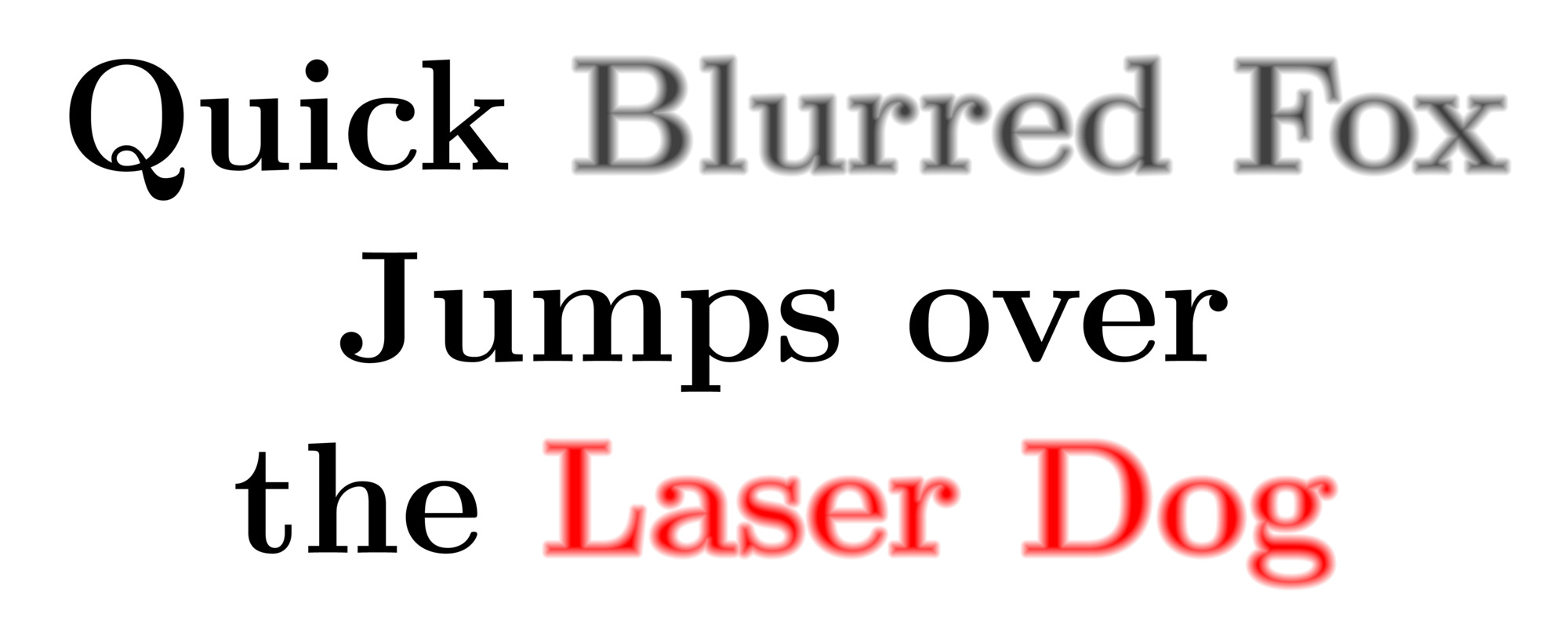
% diffuse.tex
\documentclass[tikz]{standalone}
\begin{document}
\def\textdiffuse#1{\relax%
\def\diffcoeff{50}%
\pdfliteral{q 1 J 1 j 1 Tr}%
\foreach\mixture in{5,10,...,45}{\relax%
\color{darkgray!\mixture!white}%
\pgfsetlinewidth{(105-2*\mixture)/\diffcoeff}%
\rlap{#1}%
}%
\pdfliteral{q 4 Tr}%
\color{darkgray}%
\rlap{#1}%
\pdfliteral{1 Tr}%
\foreach\mixture in{95,90,...,55}{\relax%
\color{darkgray!\mixture!white}%
\pgfsetlinewidth{(2*\mixture-95)/\diffcoeff}%
\rlap{#1}%
}%
\pdfliteral{Q}%
\pgfsetlinewidth{5/\diffcoeff}%
\color{darkgray!50!white}%
\rlap{#1}%
\pdfliteral{Q}%
\phantom{#1}%
}
\Huge\bfseries
\tikz\node[align=center,scale=10,fill=white]{
Quick \textdiffuse{Blurred Fox} \\
Jumps over \\
\colorlet{darkgray}{red}
the \textdiffuse{Laser Dog}
};
\end{document}
Convert pdf to jpg (or png in exchange for file size) with terminal command (with ImageMagick installed)
convert -density 144 -resize 2000 diffuse.pdf diffuse.jpg
Related to TeX.SX question How to make a glowing text? Borderline related to Make tikz arrows glow. See also the KTV version.
A similar contraption is used to increase text contrast
\def\KTV[#1][#2]#3{ %
\special{pdf: literal direct q 1 j 1 J 1 Tr}%
\pgfsetlinewidth{2pt}\pgfsetcolor{#1}\rlap{#3}%
\special{pdf: literal direct Q}%
\pgfsetcolor{#2}#3%
}
and hide future text in my polar code tutorial slides.
\def\focus<#1>#2{ %
\strut%
\alt<#1>{ %
#2%
}{ %
\pgfscope%
\pgfsetroundcap%
\pgfsetroundjoin%
\pgfsetfillopacity{0.05}%
\pgfsetstrokeopacity{0.05}%
\special{pdf: literal direct 1 Tr}%
\pgfsetlinewidth{4pt}\rlap{#2}%
\pgfsetlinewidth{12pt}\rlap{#2}%
\pgfsetlinewidth{20pt}\rlap{#2}%
\endpgfscope%
\phantom{#2}%
}%
}
Usages are
\KTV[red][blue]{your beautiful words}
and
\focus<2->{your beautiful words}.
Inversion
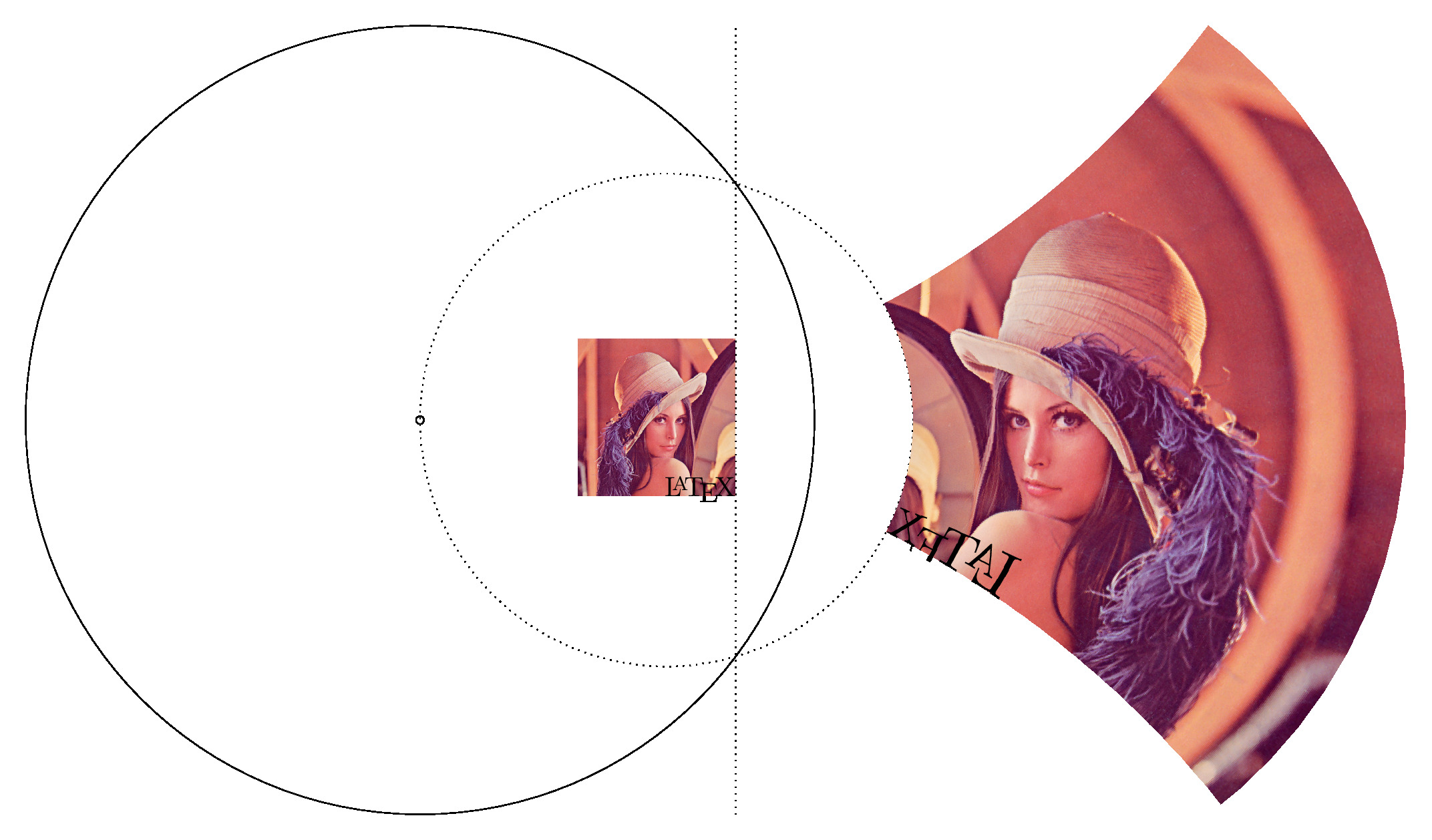
% inversion.tex
\documentclass[border=9,tikz]{standalone}
\begin{document}
\def\LennaIpsum{\includegraphics[width=2cm]{lenna.png}\llap\LaTeX}
\def\RememberInversion(#1,#2){
\expandafter\xdef\csname Inv(\u,\v)x\endcsname{\xx}
\expandafter\xdef\csname Inv(\u,\v)y\endcsname{\yy}
}
\def\RecallInversion#1(#2,#3){
\expandafter\xdef\csname#1x\endcsname{\csname Inv(#2,#3)x\endcsname}
\expandafter\xdef\csname#1y\endcsname{\csname Inv(#2,#3)y\endcsname}
}
\tikz{
\draw circle(.05)circle(5)(3,0)node{\LennaIpsum}(12.5,0);
\draw[dotted](4,-5)--(4,5)(3.125,0)circle(3.125);
\foreach\u in{-10,...,10}{
\foreach\v in{-10,...,10}{
% Affine transformation of (u, v), unit mm
\pgfmathsetmacro\uu{\u+30}
\pgfmathsetmacro\vv{\v+0}
\pgfmathsetmacro\rr{\uu*\uu+\vv*\vv}
% Take inversion, unit mm
\pgfmathsetmacro\xx{50*\uu/\rr*50}
\pgfmathsetmacro\yy{50*\vv/\rr*50}
% Remember the coordinates
\RememberInversion(\u,\v)
}
}
\foreach\u in{-10,...,9}{
\foreach\v in{-10,...,9}{
% For every square, recall the coordinates of the four corners
\pgfmathtruncatemacro\U{\u+1}
\pgfmathtruncatemacro\V{\v+1}
\RecallInversion NW(\u,\V)\RecallInversion NE(\U,\V)
\RecallInversion SW(\u,\v)\RecallInversion SE(\U,\v)
% The lower left triangle ◺
\pgfmathsetmacro\aa{\SEx-\SWx}\pgfmathsetmacro\ab{\SEy-\SWy}
\pgfmathsetmacro\ba{\NWx-\SWx}\pgfmathsetmacro\bb{\NWy-\SWy}
\pgflowlevelobj{
\pgfsettransformentries\aa\ab\ba\bb{\SWx mm}{\SWy mm}
}{
\clip(1.02mm,0)-|(0,1.02mm)--cycle;
\path(-\u mm,-\v mm)node{\LennaIpsum};
}
% The upper right triangle ◹
\pgfmathsetmacro\aa{\NEx-\NWx}\pgfmathsetmacro\ab{\NEy-\NWy}
\pgfmathsetmacro\ba{\NEx-\SEx}\pgfmathsetmacro\bb{\NEy-\SEy}
\pgflowlevelobj{
\pgfsettransformentries\aa\ab\ba\bb{\NEx mm}{\NEy mm}
}{
\clip(-1mm,.01mm)-|(.01mm,-1mm)--cycle;
\path(-\U mm,-\V mm)node{\LennaIpsum};
}
}
}
}
\end{document}
lenna.png is taken from Wikipedia.
Learn more about Lenna’s history.
Convert pdf to jpg with terminal command (with ImageMagick installed)
convert -density 300 inversion.pdf inversion.jpg
This is the final form of a series of answers on TeX.SX:
- Draw Text in different shapes
- Seasonal Challenge (Contributions from TeXing Dead Welcome)
- Geometric inversion of an image (png, jpg, bmp)
- Text in TikZ with perspective (not just slant)
See also Jelani Nelson’s slides.
Galaxy
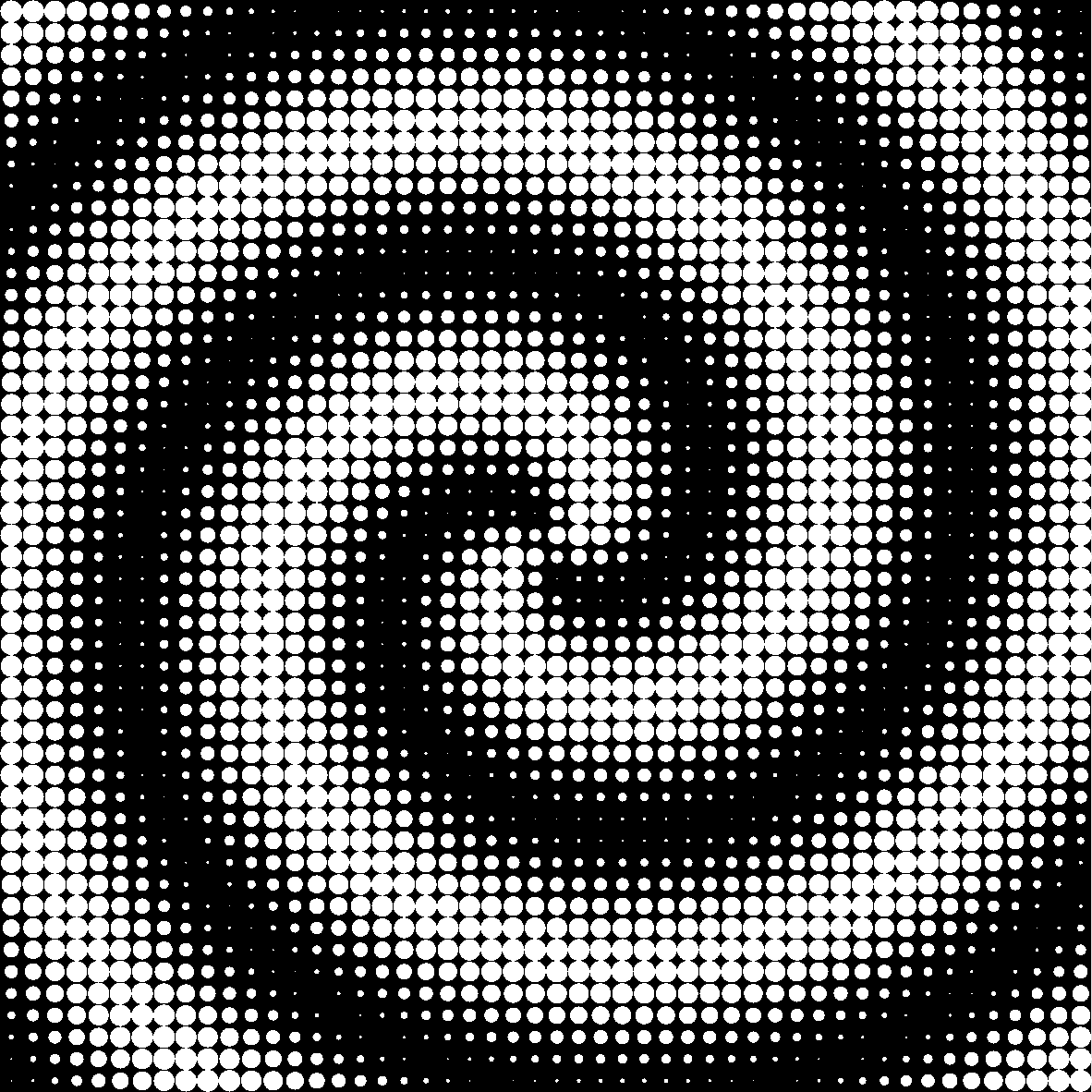
% galaxy.tex
\documentclass[tikz]{standalone}
\begin{document}
\foreach~in{0,5,...,179.9}{
\pgfdeclarefunctionalshading{Stars}
{\pgfpoint{-25bp}{-25bp}}{\pgfpoint{25bp}{25bp}}{}{
% X Y
1 index % X Y X
floor .5 add % X Y U:=floor(X)+.5
1 index % X Y U Y
floor .5 add % X Y U V:=floor(Y)+.5
2 copy % X Y U V U V
2 copy % X Y U V U V U V
25 div % X Y U V U V U v:=V/25
dup mul % X Y U V U V U v²
exch % X Y U V U V v² U
25 div % X Y U V U V v² u:=U/25
dup mul % X Y U V U V v² u²
add sqrt % X Y U V U V r:=√u²+v²
360 mul % X Y U V U V R:=360r
3 1 roll % X Y U V R U V
atan % X Y U V R θ
~ add % add the phase
add % X Y U V τ:=R+θ+phase
sin % X Y U V sin(τ)
dup mul % X Y U V s:=sin(τ)²
5 1 roll % s X Y U V
3 2 roll % s X U V Y
sub 2 mul % s X U y:=2(V-Y)
dup mul % s X U y²
3 1 roll % s y² X U
sub 2 mul % s y² x:=2(X-U)
dup mul % s y² x²
add % s q:=y²+x²
le {0 0 0} {1 1 1} ifelse % s ≤ q ? black : white
}
\tikz\path[shading=Stars](-10,-10)rectangle(10,10);
}
\end{document}
ImageMagick does not convert this pdf properly. (In general, it has issues with functional shading.) I ended up using online conversion tools.
This is inspired by http://www.peda.com/grafeq/gallery.html.
\pgfdeclarefunctionalshading is very useful.
- Graphing a non-linear inequality?
- Problems with plotting planar functions with Tikz
- Blurred tikz picture (Hermite-Gaussian modes)
- Plotting Laguerre Gaussian beam intensity in transverse and line profile via center?
- Depicting a .dat file into a contour plot in Latex
- Animated Mandelbrot
Egg

% egg.tex
\documentclass[tikz]{standalone}
\def\ditherdivide{ %%% y x dither_score power_of_2
2 mul 4 2 roll 2 mul dup cvi 1 and 2 mul
3 2 roll 2 mul dup 4 1 roll cvi 1 and
3 mul xor 5 4 roll add 4 div 4 3 roll
}
\pgfdeclarefunctionalshading{ordered dithering egg}
{\pgfpoint{0bp}{0bp}}{\pgfpoint{50bp}{50bp}}{}{
%%% X:[0,50] Y:[0,50]
50 div exch 50 div 0.5 1
%%% y:[0,1] x:[0,1] 0.5:dither_score 1:power_of_2
\ditherdivide
\ditherdivide
\ditherdivide
\ditherdivide
\ditherdivide
\ditherdivide
\ditherdivide
\ditherdivide
%%% Y:[0,power2] X:[0,power2] score power2
4 2 roll floor 2 index div % score power2 Y x
3 1 roll floor exch div % score x y
%%% score x:[0:1] y:[0,1]
.5 sub 2.2 mul exch .5 sub 2.2 mul % recenter and rescale
1 index 5 div 1.3 add mul % score x y(1.3+x/5)
%%% score u:=x v:=y(1.3+x/5)
dup dup mul % score u v v^2
2 index dup mul add % score u v r=radial
1 ge {pop pop 0.5} {
% https://tex.stackexchange.com/a/75994
dup dup mul 2 index dup mul add 1 sub % -w(u,v)^2
.3 dup mul .4 dup mul add 1 sub % -w(.3,.4)^2
mul sqrt % ww'
exch .3 mul add % += vv'
exch .4 mul add % += uu'
dup abs add 2 div % keep if ≥ 0 otherwise 0
.1 add % affine transform light
}ifelse
%%% score light
le {1} {0} ifelse % sum<light
}
\begin{document}
\tikz\shade[shading=ordered dithering egg]
(0,0)rectangle(4in,4in);
\end{document}
Using macOS Preview.app to convert pdf to png (with resolution 256
pixel/inch). But if you look closely, the “correct” resolution should
be 128 pixel/inch. Turns out there are some rounding issues no matter I
use floor or round in the code. The issues go away when the
resolution is doubled.
This is a derivation of my answer to How can I add stippling to elements of my tikz diagrams? Drawing an egg here is motivated by Kurzgesagt’s video The Egg - A Short Story.
This is not TikZ. But this piece of TeX code
generates my old, deprecated email hpwang2@illinois.edu.
\def~#1#2{#1\catcode`#27
~}~^^((((7000077777!!!!.
''''rrrr44440444400)))),
,,,,,)))())./////)))3333
~....%$$$$577757775\endr
This piece of TeX code generates my old, deprecated email
hsw001@ucsd.edu.
\def~#1#2{#1\catcode`#27
~}~^^((((733337)))pppppq
qqq444400005####5553$$$$
mmmn\%%%%666647775)\endq
Try it on Overleaf! But either you need to change the compiler to TeX manually (which is not quite easy), or you can wrap the code above using:
\documentclass{article}
\let\oldend=\end
\def\end#1~{\let\end\oldend}
\begin{document}
...
\end{document}
The trick is that TeX has this neat feature that ^^68 is interpret as
the letter h because the ASCII code for the letter h is 0x68. TeX
also interprets ^^( as the letter h because the ASCII code for the
left parenthesis ( and the ASCII code for the letter h differ by
sixty-four. With this trick, lowercase letters abcd... can be
expanded into ^^61^^62^^63^^64... or, less obviously,
^^!^^"^#^^$....
However, it would be less mysterious if one sees two superscript symbols
^^ everywhere in a code. So TeX also has this neat feature that it
doesn’t have to be two superscript symbols; any repeated symbols whose
category code is seven will work. For instance, if we change the
category code of the left parenthesis to seven by \catcode`(=7,
then ((( equals ^^( equals h. Similarly, if you change the
category code of the number six to seven by \catcode`6=7, then
6668 equals ^^68 equals h.
Now it becomes a matter of looking up every letter in your email address
and choose either ^^68 or ^^(, whichever maximizes the obscurity.
These pieces of code are motivated by the (unnecessary) need to hide
one’s email address from spammers. This is inspired by the famous
file xii.tex.
Bonsai

\documentclass[tikz]{standalone}
\begin{document}
\usepgfmodule{parser}
\pgfparserdef{bonsai}{initial}{the character :}{
% \PackageWarning{bonsai}{execute :}
\definecolor{root}{Hsb}{40,1,0.3}
\definecolor{leaf}{Hsb}{80,1,0.6}
\def\bonsaiwidth{5pt}
\def\fanout{120}
\pgfmathsetmacro\angle{\fanout*1.5 + 30}
\def\factor{100}
}
\pgfparserdef{bonsai}{initial}{the character <}{
% \PackageWarning{bonsai}{execute <}
\pgfmathsetmacro\angle{\angle - \fanout}
\path (0, 0) coordinate (stem);
\bgroup\iffalse\egroup\fi
\pgfmathsetmacro\angle{\angle * 0.75}
\pgfmathsetmacro\factor{\factor * (0.8 + abs(\angle/1000))}
\pgftransformshift{\pgfpointpolarxy{\angle}{\factor/100}}
\draw [root!\factor!leaf, line width=\factor/100*\bonsaiwidth]
(stem) to[in=\angle+180+rand*20, out=\angle+rand*20] (0, 0);
\pgfmathsetmacro\angle{\angle + \fanout*1.5}
}
\pgfparserdef{bonsai}{initial}{the character >}{
% \PackageWarning{bonsai}{execute >}
\iffalse\bgroup\fi\egroup
}
\pgfparserdef{bonsai}{initial}{the character .}{
% \PackageWarning{bonsai}{execute .}
\fill [leaf] (0, 0) circle [radius=\factor/500];
}
\pgfparserdef{bonsai}{initial}{the character ;}{
% \PackageWarning{bonsai}{execute ;}
\pgfparserswitch{final}
}
\begin{tikzpicture}
\tikzset{rotate=90}
\pgfparserparse{bonsai}:
<<<.><<.><.>>><<<<.><.>><<<.><.>><<<.><.>><<<<.><.>><<<.><.>
><.>>><<<.><.>><.>>>>>><<.><.>>>><<<.><.>><<<<<.><<.><<.><<.
><.>>>>><<.><<<><.>><.>>>><<<.><.>><<<<.><.>><.>><.>>>><<<<.
><.>><<<.><.>><<.><.>>>><<<.><.>><<<<<.><.>><<<<.><.>><.>><.
>>><<.><.>>><<<.><.>><.>>>>>>>
;
\tikzset{rotate=-90}
\filldraw [red!50!black, line width=2pt]
(-1, 0) -- (1, 0) -- (.7, -.5) -- (-.7, -.5) -- cycle;
\end{tikzpicture}
\end{document}
Convert pdf to png with terminal command (with ImageMagick installed)
convert -density 600 bonsai.pdf bonsai.png
Pixel art
![]()
% pixel.tex
\documentclass[tikz]{standalone}
\usepgfmodule{parser}
\begin{document}
\def\pixelartinitial{
\def\pixelartx{0}
\def\pixelarty{0}
\catcode13=12
}
\def\pixelartnextrow{ % next row = new line = enter
\def\pixelartx{0}
\pgfmathsetmacro\pixelarty{\pixelarty - 1}
}
\def\pixelartput#1{ % #1 is a color or tikz options
\pgfmathsetmacro\pixelartx{\pixelartx + 1}
\fill [color={#1}] (\pixelartx, \pixelarty) rectangle +(1.05, 1.05);
% 1.05 is overshoot; necessary to avoid white gaps
}
\def\pixelartfinal{
\catcode13=5
\pgfparserswitch{final}
}
\pgfparserdef{pixel art}{initial}{the character <}{\pixelartinitial}
\pgfparserdef{pixel art}{initial}{the character >}{\pixelartfinal}
\catcode13=12\relax%
\pgfparserdef{pixel art}{initial}{the character ^^M}{\pixelartnextrow}%
\catcode13=5\relax
\pgfparserdef{pixel art}{initial}{the character '}{\pixelartput{gray,7: black,0; white,7}}
\pgfparserdef{pixel art}{initial}{the character -}{\pixelartput{gray,7: black,1; white,6}}
\pgfparserdef{pixel art}{initial}{the character ;}{\pixelartput{gray,7: black,2; white,5}}
\pgfparserdef{pixel art}{initial}{the letter l}{\pixelartput{gray,7: black,3; white,4}}
\pgfparserdef{pixel art}{initial}{the letter C}{\pixelartput{gray,7: black,4; white,3}}
\pgfparserdef{pixel art}{initial}{the letter D}{\pixelartput{gray,7: black,5; white,2}}
\pgfparserdef{pixel art}{initial}{the letter H}{\pixelartput{gray,7: black,6; white,1}}
\pgfparserdef{pixel art}{initial}{the letter M}{\pixelartput{gray,7: black,7; white,0}}
\begin{tikzpicture}[x=1mm, y=2mm]
\pgfparserparse{pixel art}<
CCCDCDDDCDCDDCCCCDCDDCDDDCCDCDCCDCDCCDDCCDDDDDDDCDCDDDCDDDDD
CllClllCllCllCCClllClllClllllCCClCCCCCCCCCCCCCCCCCCCCClCClll
DlClCCCClCCCCCCllCCCCCCCClCCCCCCClCC;;;;;;;;;;;;;;;l;l;;CCCC
DC;CC;;;lll;;l;;;lCCCC;CC;;;;l;ll;;;l;ll;l;;;;;;;;ll;;lCC;lC
l;;l;l;;;l;lllll;;;;l;;;l;llDCCCDlCC;lll;;;;;lll;;;;lllCC;ll
Cl;l;lllllll;;l;;;l;;l;CCHHHMDHDDDHHCClll;llll;ll;;l;ll;;;;;
l;;;;ll-lllll;;lllll--CCCl-;l;lDCHHDHDDlllll;llll;;l;;llll;;
D;llll-;-;-;-----ll;-lHl-'--';lCDHHHHHDH;lllll;l;;llll;l;;ll
C;ll-;l-;-;-;-;-;--;lDC-''''';;llCCHHHDDCllCC;l;lll;ll;;;ll;
HDlClCll;;CCll---;;CHHC;;;;-;;;;CDCHHHDHHCDDllCll;lll;l;CCCC
DHDDlCClllCDDDC;ll;DDHllDD;lC;lDlCDHHDDHHCCCDCDDDC;;;llCCCCC
HDDDllCllDCDDDDDCClCHD;;--;;;;;;-;DHHHHDDCDCCDCCDC;l;CClClCl
HDCCDDDDDDCDCCCCDCDHHDD-;-;ll;;lCDHDDDDDHHCCDDDDDClllCDDDDDD
DCHHCDCCCCDDCCCDDDDDHDDl;llHDl;CDCHDHDDHHHHHHHHHHCCCCCCCDHDC
DHHHCCDCDCCCCDCCCCHDHHDCll;CCCClCCHHHDDDHDDCCDCCCCDCDCHDCCDC
DHHHCCCCCHDHDCCCDCDHHHHDHl;llDCDDHHDHDDHHHHCCCCCCCDDHHCCDDCC
DDHDHHHDCDCDDCDDlllDDHDDDHMHHDHHHDHHHHDDDDDHHCCCHDHHHHHCHCCH
DHHHHDCCDCCDDllllCCCHHHDHDHClDCCCDDCHHDHDDHDHCCCCDCCCCCDHCCD
HHCDDCCDDDCCCHCDHHDDDHHDDDCC;;Cl;;;CCDDHHDDHDDDHHHHDDCCCCDHH
DCDCCCCCCCCCCHDHDDDHHHDCC;-;;;-;;-;;DHHDDDDDDHHDDlDDDCCDHHHH
HCDCCHCDCCDCHHDHHHHDDDH;;'''';;';;-;CHHHDMDHDDDDHDDDCDDDCDHH
DHCCCHCCDllDDHCHHHDDCl;;'''''''-;--;CHHCDDDDCHDMMHHCDCDDlCCC
DDDCDCCCCDDDDDHHHHHHl-'-''-'--''-'-lCDDDDDDHHDHMMHMMDDHHCClD
DHDCCCDDCDDDCHDDDHDHCl;;l-'-----';CDDHHDDHMMMHMHMMMMDHHHHHHH
HHHCDDDCDCDHHDHDDDHDHHDDHCDlCCCCCHDDDDMDHHHDMMMMHMMMMHHDDHDH
HHDHCDCDCCCHHDDDDHDHHDHHCHHDHDDHDHDMHDHDDDDHHDDDMMMMMMDHHDDH
DHHHCDDCCDHDDDHHHDDDDDDHHHDDHHHHDHMMMDDMDDDDHDDHMMMMMMDHHDDH
HHDDllCllDDDDDDHDHDDHMDDDDDDDDDDMMMMMMDDHDHHHMHMHMMMDMMDHHHD
DHCDCDCCHHHHDDDDDDHDDMMHHDDDHDDMMMMMMMHDHDHMHHMMMMMMMMMHDHDD
DDDHHHHDDHHHHHDHDHDDHMDMMDDDDMMMHMMMMMHDMMMMMHMHMMMHMMMMMHDD
DHDDHHDHHDDDHHHHHDDHDMDMMHHDMMMMDMMMMMMMHHMMHMMMHMHMMMMHMDDD
DHDDDDDDHHDDDDDDDDHMDDDDDDMHMMHMHHMHMMMMMHHMMMHMMMMMMMMMHDDH
DHDDDDDHCCCHHCHDDHMDMMHHHMHMHMHHMMMHMMMMMMMMMMHMMMHMMMMMHMHD
DDHDDDHHCCCDCCCCD;lllCDCHDH'HMMMMMMMHMMMMMMMMMMMHMMHMMHHMHMM
DDDDDDDDDHHHDHDCCllllll;;ClCHMHHMMHHHHHHHHMMMMHMHMHMMMMMMMHM
DDDDDDDHHDDDHHDDCDDlll;;;;lCl;CHDDHHDDDDDDHDMMMHMHMMMMMMMMMM
DDMMMMHMDDMMDDMHHHCDClCCCCClDllDCDCCHHHHHDDDHHMMHMMMMHMHHMMM
MDMHDMHDMDMMMHHDDC;CDCDDllllCDHHHCHDHHHHHDDMDDHHHMMMHHMHMMDD
MMHMMDDDHMMMMHCCDDClCDHCCCllCCDDHDDDHDDDDMDDMMMHMMHMMMMHMMDD
MMMMMMMMMMMMMDHCCDClDHHDHHMDHHDHHDHMMMHMMMHMMMMHHMMMMMHMMMMM
MMHMMDMMMMMMMHMMHDCMDDDDDHDHDDMMHHMHMHMMMMHHMMHMHMHMHMMMMMMM
MMMMMMHMDHDDMMMMDDDDDDDDDDDMHMHHMMMHMMMMHMMMMMHMMMMMHHHHMHMM
MHMMMMMHDMMHMMDDDMMMMHMMMMHMHHMHMMMMHMHMMHHHHMMHMHHHMMMMMMMH
MMMMMHMMHMMDDDMMMMMHMMMMMHHHHMHMMMHMHMHMHMHHHHMHMMHMHMHMHMMM
MMMMMMMMDDDDDDDMMMMMMMMMMMMHMMMHMHMMHHMMMMMMMMHHHMMMMMMHMMMM
>
\end{tikzpicture}
\end{document}
Would it be nice if TikZ is WYSIWYG?
Convert pdf to png with terminal command (with ImageMagick installed)
convert -density 300 pixel.pdf pixel.png
Another approach is to
use \pdfliteral.